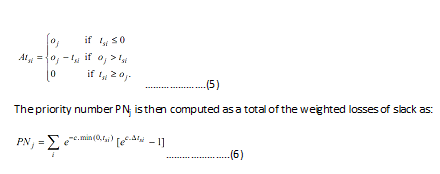New Rule with Local One Step Ahead Prediction: WLS Rule
Along with an observation to improve the performance measure of the system, a dynamic posteriori rule, the WLS that is weighted loss of slack rule used.
The weighted loss of slack rule evaluates the condition of all other operations in the respective queue whether operation j would be scheduled. This decision will reason a loss of slack for all the other operations waiting in the queue. It is most crucial, whether an operation would have negative slack tsi after scheduling of operation j. Hence, the unsafe loss of slack of operation i because of the scheduling of operation j before i is:

In Eq. (6), the differences of the exponentially weighted slack after and before the scheduling of operation j are totaling up. The exponential weighting offers an incentive to prefer long operations (that reason larger losses of slack than short ones) while their slack reduces and therefore assists to maintain the maximal tardiness same whereas still providing minute throughput times on the middle.
The queue is further divided into two subsequences. The high priority queue consists of those operations for that tsj < maxJ oj oi, that is the operations such have negative slack or might acquire negative slack because of the scheduling of several other operations before operation j. These dangerous operations are ordered as per to the above Eq. (6). The uncritical operations are scheduled as per to the ODD rule.
This is obvious that the WLS rule is an extremely good compromise among the two classes of rules. For extensive queues and high pressure, this dominates SL/OPN both in Tmean and Trms,
and it performs well in all situations while avoiding extreme values of Tmax. Thus, it can be said that it is prime candidate for a good simple priority rule especially in decentralized scheduling.